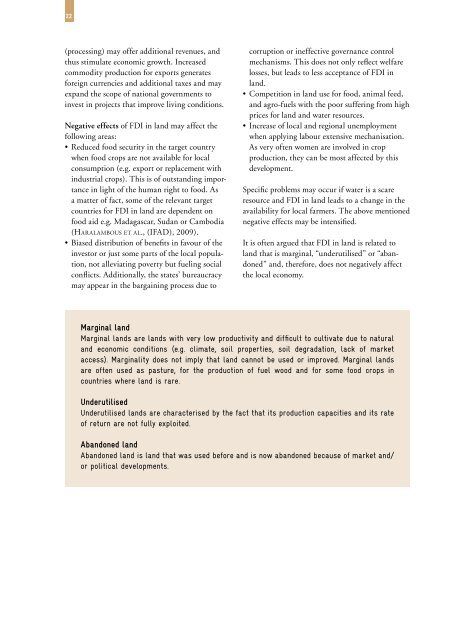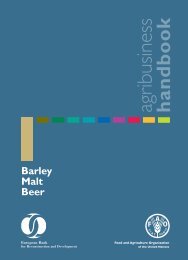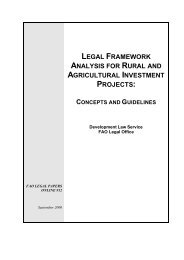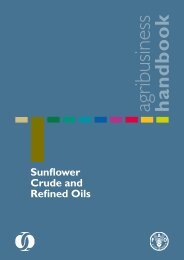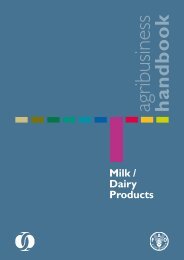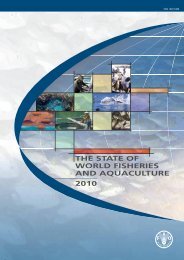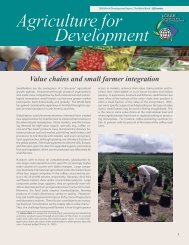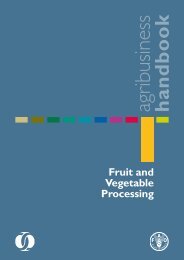22(process<strong>in</strong>g) may offer additional revenues, andthus stimulate economic growth. Increasedcommodity production for exports generatesforeign currencies and additional taxes and mayexpand the scope of national governments to<strong>in</strong>vest <strong>in</strong> projects that improve liv<strong>in</strong>g conditions.Negative effects of <strong>FDI</strong> <strong>in</strong> land may affect thefollow<strong>in</strong>g areas:• Reduced food security <strong>in</strong> the target countrywhen food crops are not available for localconsumption (e.g. export or replacement with<strong>in</strong>dustrial crops). This is of outstand<strong>in</strong>g importance<strong>in</strong> light of the human right to food. Asa matter of fact, some of the relevant target<strong>countries</strong> for <strong>FDI</strong> <strong>in</strong> land are dependent onfood aid e.g. Madagascar, Sudan or Cambodia(Haralambous et al., (IFAD), 2009).• Biased distribution of benefits <strong>in</strong> favour of the<strong>in</strong>vestor or just some parts of the local population,not alleviat<strong>in</strong>g poverty but fuel<strong>in</strong>g socialconflicts. Additionally, the states’ bureaucracymay appear <strong>in</strong> the barga<strong>in</strong><strong>in</strong>g process due tocorruption or <strong>in</strong>effective governance controlmechanisms. This does not only reflect welfarelosses, but leads to less acceptance of <strong>FDI</strong> <strong>in</strong>land.• Competition <strong>in</strong> land use for food, animal feed,and agro-fuels with the poor suffer<strong>in</strong>g from highprices for land and water resources.• Increase of local and regional unemploymentwhen apply<strong>in</strong>g labour extensive mechanisation.As very often women are <strong>in</strong>volved <strong>in</strong> cropproduction, they can be most affected by thisdevelopment.Specific problems may occur if water is a scareresource and <strong>FDI</strong> <strong>in</strong> land leads to a change <strong>in</strong> theavailability for local farmers. The above mentionednegative effects may be <strong>in</strong>tensified.It is often argued that <strong>FDI</strong> <strong>in</strong> land is related toland that is marg<strong>in</strong>al, “underutilised” or “abandoned”and, therefore, does not negatively affectthe local economy.Marg<strong>in</strong>al landMarg<strong>in</strong>al lands are lands with very low productivity and difficult to cultivate due to naturaland economic conditions (e.g. climate, soil properties, soil degradation, lack of marketaccess). Marg<strong>in</strong>ality does not imply that land cannot be used or improved. Marg<strong>in</strong>al landsare often used as pasture, for the production of fuel wood and for some food crops <strong>in</strong><strong>countries</strong> where land is rare.UnderutilisedUnderutilised lands are characterised by the fact that its production capacities and its rateof return are not fully exploited.Abandoned landAbandoned land is land that was used before and is now abandoned because of market and/or political developments.
23However, such lands are often important forthe livelihoods of poor rural communities. Forexample, they are used for graz<strong>in</strong>g, livestocktransit routes, as well as for collection of fuelwood, biomass, wild fruits and nuts, medic<strong>in</strong>alplants and natural products. Moreover, they grantaccess to water sources. Such lands can contributeup to a quarter of the <strong>in</strong>come of poor households,with the poorest households be<strong>in</strong>g most dependenton them. The role of this land becomes even morecrucial <strong>in</strong> times or conditions of shock (e.g. cropfailure, HIV/AIDS) and for the most vulnerablegroups. Furthermore, the tenure status of this landmay be very complex, with the state assert<strong>in</strong>g landownership but exercis<strong>in</strong>g little control at locallevel, and local groups claim<strong>in</strong>g rights based onlocal customary tenure systems that may lacklegally enforceable status. In such a context,demand from outside for land may further underm<strong>in</strong>ethe land rights of rural communities (seealso v. Braun and Me<strong>in</strong>zen-Dick, 2009).3.2. Possible socio-cultural impacts of<strong>FDI</strong> <strong>in</strong> land on rural livelihoodsSocio-cultural impacts of <strong>FDI</strong> <strong>in</strong> land on rurallivelihoods and <strong>in</strong> terms of susta<strong>in</strong>able developmentare closely related to the above-mentionedeconomic effects.As positive effects, follow<strong>in</strong>g improvements arepossible:• Improv<strong>in</strong>g liv<strong>in</strong>g conditions and susta<strong>in</strong>abledevelopment by additional <strong>in</strong>come possibilities<strong>in</strong> rural areas which can be l<strong>in</strong>ked to the employmentoption with<strong>in</strong> the <strong>in</strong>vestments projectdirectly or due to an <strong>in</strong>crease <strong>in</strong> other bus<strong>in</strong>essoptions like cater<strong>in</strong>g and others. Additionally,liv<strong>in</strong>g standards may be <strong>in</strong>creased if overallliv<strong>in</strong>g <strong>in</strong>frastructures may be improved e.g. byestablish<strong>in</strong>g schools or health care organisations.• Reactivation of abandoned land and valueadd<strong>in</strong>g of underutilised land leads to <strong>in</strong>comegeneration <strong>in</strong> rural areas.• An <strong>in</strong>crease <strong>in</strong> work<strong>in</strong>g standards is possible ifforeign <strong>in</strong>vestors apply their domestic standardsto the employees which may be higher thanthose <strong>in</strong> target <strong>countries</strong>.• Better <strong>in</strong>tegration of smallholder/family farmers,who may <strong>in</strong>tegrate <strong>in</strong> associations.• An <strong>in</strong>crease <strong>in</strong> civil safety and political stabilitycan be the outcome of improved liv<strong>in</strong>g conditionsand a better <strong>in</strong>tegration of local small-sizefarmers.Depend<strong>in</strong>g on the specific design, these abovementionedadvantages may not be achieved but<strong>in</strong>stead turn <strong>in</strong>to a burden for the target countryif the follow<strong>in</strong>g possible negative effects occur:• A strong competition for rema<strong>in</strong><strong>in</strong>g land can<strong>in</strong>voke land conflicts, lead<strong>in</strong>g to civil andpolitical <strong>in</strong>stability.• Reduc<strong>in</strong>g access of land and marg<strong>in</strong>alisation ofsmall-size land owners has negative effects onany development geared towards the needs ofthe poor. Reduced access to land can lead todisplacement of <strong>in</strong>digenous people or theexclusion of rural communities and <strong>in</strong>creaserural poverty, especially for women. Access touse of common lands can be restricted (collect<strong>in</strong>gfuel wood, wild fruits, medic<strong>in</strong>al plants, etc.or graz<strong>in</strong>g livestock). As a consequence, socioculturalcohabitation between different socioprofessionalgroups (e.g. livestock and cropfarmers, pastoralists, etc.) can be impeded.• Emigration of local farmers can <strong>in</strong>crease socialtensions and urban poverty. If former landownerslose their livelihood this may <strong>in</strong>duce amigration flow <strong>in</strong>to cities and <strong>in</strong>crease urbanburden or poverty. Plus, a loss of <strong>in</strong>herentcultural habits may occur.• Immigration of foreign employers can <strong>in</strong>vokesocial frictions. Income disparities <strong>in</strong> localcommunities may arise from the fact that oftenhighly educated management personnel will berecruited from the <strong>in</strong>vestor’s <strong>countries</strong> whereaslow-level work will probably be done by localpersonnel. Especially if the imported employersbenefit from better work<strong>in</strong>g standards or a firm’sbetter healthcare system, social frictions can<strong>in</strong>crease. Cultural and l<strong>in</strong>gual divergences canalso worsen social systems.


